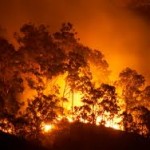The extensive fire damage that is happening to the forests in Indonesia as a result of El Niño and the associate aftermath in terms of smoke and haze greatly affect our environment.
Fire can and does result in enormous losses in terms of resources, products, environmental quality and human life, according to the Food and Agricultural Organization (FAO).
“Short climatic changes may also affect forest regeneration, both spontaneous and that assisted by man. Forest resources also comprise a vast array of non wood forest products, of critical importance to the food supplies of local people and to their economies and these may suffer from El Niño,” FAO said.
According to FAO, the relatively long growing season of the most forest resources, the climate change impacts of El Niño on trees tend to be less dramatic than on annual agricultural crops.
Agroforestry systems in which trees and agricultural crops are raised in a mutual relationship may also be affected according to FAO.
Forestry contributes to food security in three main ways, through the direct provision of food, through the protection of the agricultural base for food production and through the generation of employment and income.
With regard to the direct provisions of food, the immediate impact of El Niño will likely be on the many non wood forest products which include nuts, tree flowers and honey.
The supply of these products may be adversely affected by El Niño says FAO. But if the soil and water protection provided by the forests is destroyed, agricultural land may permanently lose its productivity.
Another grave risk associated with El Niño is a local shortage, in areas affected by fire, of the forest fuel that are fundamental for cooking, heating energy and sources of income and employment opportunities of most rural populations.
